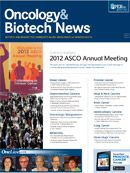Publication
Article
Oncology & Biotech News
Lapatinib Equivalent to Trastuzumab as Neoadjuvant Therapy, but Less Effective in Metastatic Setting
Author(s):
Two phase III studies presented at ASCO 2012 explored the role of lapatinib in the treatment of HER2-positive breast cancer.
Karen A. Gelmon, MD
Two phase III studies presented at ASCO 2012 explored the role of lapatinib (Tykerb) in the treatment of HER2-positive breast cancer. A study in the neoadjuvant setting suggested that lapatinib could be a potential substitute for trastuzumab (Herceptin) or used along with trastuzumab in combination with paclitaxel,1 while a second study found that lapatinib combined with taxane-based chemotherapy was less effective than trastuzumab with greater toxicity as first-line therapy for patients with metastatic HER2-positive breast cancer.2
Formal discussant of both trials, Gunter von Minckwitz, MD, PhD, University of Frankfurt, Germany, said that the concept of dual HER2 blockade continues to be a strategy to pursue in patients who overexpress HER2.
Neoadjuvant Trial
Evidence from the NSABP B-41 phase III trial supports the use of dual blockade with lapatinib plus trastuzumab or lapatinib substituted for trastuzumab in combination with standard chemotherapy in the neoadjuvant setting. The study was designed to determine whether dual HER2 blockade with trastuzumab plus lapatinib improved pathological complete response (pCR) in combination with standard chemotherapy and to compare lapatinib versus trastuzumab in this setting, explained lead author André Robidoux, MD, University of Montreal Hospital Center, Canada.
Using dual blockade, pCR was numerically, but not statistically, higher compared with trastuzumab in patients with operable HER2-positive breast cancer (62% versus 52.5%, respectively). In patients who were hormone receptor—positive, pCR rates for the combination were 55.6% versus 46.7% for trastuzumab plus chemotherapy; in the hormone receptor—negative group, pCR rates were 73% and 65.5%, respectively. The pCR rates for lapatinib versus trastuzumab were similar in the overall population and in subgroups characterized by hormone receptor status.
However, use of lapatinib as a component of chemotherapy was associated with greater toxicity. Significantly more patients assigned to a lapatinibcontaining arm discontinued therapy versus trastuzumab alone: 63% versus 68%, respectively (P = .01). Grade 3 or 4 adverse events were higher in the lapatinib- containing arms compared with trastuzumab. Diarrhea was the most frequent toxicity (including grade 3 events) associated with lapatinib. Cardiac adverse events were infrequent in both arms.
Metastatic Breast Cancer
Trastuzumab prolonged progression-free survival (PFS) compared with lapatinib when both drugs were added to taxane-based chemotherapy for first-line treatment of HER2-positive metastatic breast cancer, according to interim results of the NCIC CTG MA.31/GSK EGF 108919 trial. In the overall population, median PFS was 11.4 months with the trastuzumab combination versus 8.8 months with lapatinib plus taxane-based chemotherapy (P = .01). Results were more robust in favor of trastuzumab in a subgroup of patients with centrally confirmed HER2-positive metastatic breast cancer: 13.7 months in the trastuzumab arm versus 9 months in the lapatinib arm (P = .003). No difference in overall survival was observed for the two treatment arms.
The trial was halted early by the Data Safety and Monitoring Committee when it became evident that trastuzumab was superior.
Karen A. Gelmon, MD, British Columbia Cancer Agency-Vancouver Cancer Center, Vancouver, Canada, reported results of this study.
The analysis was based on 636 patients randomized 1:1 to weekly paclitaxel or docetaxel every 3 weeks for 24 weeks in combination with oral lapatinib (1250 mg/day during taxane therapy followed by 1500 mg until disease progression) or trastuzumab (loading dose, then 2 mg/kg weekly or 6 mg/kg every 3 weeks during taxane therapy followed by 6 mg/kg every 3 weeks until progression).
At baseline, both treatment arms were well balanced. Forty-six percent had liver metastases. About 18% had received prior trastuzumab and about 20% had been treated with a taxane as adjuvant or neoadjuvant therapy.
In addition to shorter PFS with lapatinib, the drug had greater toxicity. Treatment was discontinued by 17.8% of patients in the lapatinib arm due to toxicity compared with 10.6% of those who received trastuzumab. The most frequent side effects associated with lapatinib included diarrhea, rash, and anorexia. Serious adverse events, including diarrhea and febrile neutropenia, were also more frequent in those taking lapatinib.
Because of cardiotoxicity concerns with the combinations, left ventricular ejection fraction was monitored while on treatment. The incidence of decreased left ventricular ejection fraction of 20% or more from baseline was quite low and only occurred in the trastuzumab arm.
Commenting on this paper, von Minckwitz said that this study adds to the mounting evidence that lapatinib is not as active in several breast cancer settings. He said this could be due to the rapid development of secondary resistance.
- Robidoux A, Tang G, Rastogi P, et al. Evaluation of lapatinib as a component of neoadjuvant therapy for HER2+ operable breast cancer: NSABP protocol B-41. J Clin Oncol. 2012;30(suppl; abstr LBA506).
- Gelmon KA, Boyle F, Kaufman B, et al. Open-label phase III randomized controlled trial comparing taxane-based chemotherapy (Tax) with lapatinib (L) or trastuzumab (T) as first-line therapy for women with HER2+ metastatic breast cancer: Interim analysis (IA) of NCIC CTG MA.31/GSK EGF 108919. J Clin Oncol. 2012;30(suppl; abstr LBA671).










